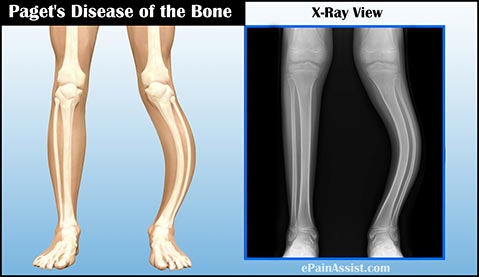What Is Paget’s Disease Of The Bone?
Paget’s Disease as stated is a chronic pathological condition of the bones in which there is a disorder of the normal process of bone remodeling. Paget’s Disease affects the skeletal bones. Studies estimate that about 1% of population in the United States have Paget’s Disease. In rare instances, a form of Paget’s Disease is also found in children known as Juvenile Paget’s Disease. Paget’s Disease is also known by the name of Osteitis Deformans.

How Is Paget’s Disease Of The Bone Caused?
There is no known cause for the development of Paget’s Disease. As of late, studies have shown that some genes re linked with this disease to include the Sequestrosome-1 gene on chromosome 5. A viral infection is also a causative factor for development of Paget’s disease in people who have these genes.
Facts About Paget’s Disease Of The Bone
Some Facts About Paget’s Disease Are:
- It is a chronic disorder of the bones
- Usually it causes no symptoms.
- Paget’s Disease causes pain in the bones and joints along with headaches, hearing loss, pressure on nerves, bowing of limbs, or spinal curvature
- It can be diagnosed with x-rays, blood draws, and bone scans.
- Paget’s disease can also cause other related medical problems
- Some of the treatment options for Paget’s Disease are antiinflammatory medications, pain medications, etc., and medications designed to slow down the progress of Paget’s Disease
- Surgical procedures may be required in cases of severe damage to joints, fractures, or extremely deformed bones.
What Are The Symptoms Of Paget’s Disease Of The Bone?
Generally Paget’s Disease does not cause any symptoms and more often than not is an incidental finding when radiographs are obtained for some other medical condition. However, Paget’s Disease can cause pain in the bones, bone deformity, fractures, and arthritis. The pain experienced in the bone from Paget’s Disease will be from the bone that gets affected. Some of the bones that are commonly affected by Paget’s Disease are spine, femur, pelvis, skull, clavicle, and humerus.
Major symptoms of Paget’s Disease are dependent on the bones that are affected by it and the extent of damage to the bones. In cases of enlarged bones, there can be impingement of adjacent nerves resulting in tingling and numbness. Also observed can be bowing of the legs. If there is involvement of the hip or knee bones, then there will be arthritis as well as pain or stiffness in the hip and knee. In cases when the skull bones get affected then it may lead to frequent headaches and even hearing loss or visual impairment.
How Is Paget’s Disease Of The Bone Diagnosed?
The usual method for diagnosing Paget’s Disease is an x-ray which may show deformity of the bones. Other imaging tests like bone scan, MRI, or CT can also be done for confirmatory diagnosis. Blood draws will show elevated alkaline phosphatase levels, which is a hallmark of Paget’s Disease. Bone scan can show the degree of involvement of the bone in Paget’s Disease.
What Are Treatments For Paget’s Disease Of The Bone?
The main aim of treatment for Paget’s Disease is to control and slow down the disease process and managing the complications if present. When there are no symptoms caused by Paget’s Disease and the blood tests are relatively normal then no particular treatment is rendered or required. Antiinflammatory medications can be given to calm down pain. In cases of deformity of the bone, supports such as heel lifts or specialized footwear can be given. Surgical procedures may be required in cases of severe damage to the bones, joints, or in cases of fractures. Surgery is only done after conservative approach has failed to relieve the problem.
What Is The Overall Prognosis Of Paget’s Disease Of The Bone?
The overall prognosis for Paget’s Disease is usually good, especially if treatment is done relatively early and no major damage has been inflicted on the bones. Paget’s Disease strikes mostly in the bones of the spine, skull, pelvis, and lower legs. Usually, the progression of symptoms is relatively slow and this disease does not spread to normal bones of the body. The treatments control Paget’s disease and even relieves the symptoms, but in no way it cures this disease.
- National Institute of Arthritis and Musculoskeletal and Skin Diseases (NIAMS): NIAMS is a part of the National Institutes of Health (NIH) and provides authoritative information on bone and joint disorders, including Paget’s Disease. Website: https://www.niams.nih.gov/
- Mayo Clinic: Mayo Clinic offers reliable information on Paget’s Disease, including its causes, symptoms, diagnosis, and treatment options. Website: https://www.mayoclinic.org/
- MedlinePlus – Paget’s Disease of Bone: MedlinePlus, a service of the U.S. National Library of Medicine, provides easy-to-understand information on Paget’s Disease and related resources. Website: https://medlineplus.gov/
- Cleveland Clinic – Paget’s Disease of Bone: The Cleveland Clinic provides comprehensive information on Paget’s Disease, its symptoms, diagnosis, and treatment modalities. Website: https://my.clevelandclinic.org/
- National Health Service (NHS) – Paget’s Disease: The NHS website offers valuable information on Paget’s Disease, its symptoms, and treatment options. Website: https://www.nhs.uk/
Also Read:
